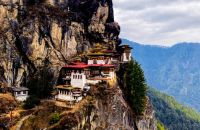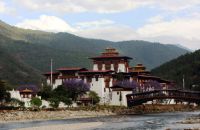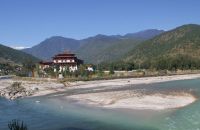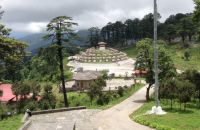Talk with our local travel specialist who can help organize your trip.
Everything you need to know to plan your trip to Bhutan for 2025 and 2026
Bhutan, the land of the thunder dragon’, is a hidden paradise nestled deep in the Himalayan mountains. The country is known for being the first carbon-negative country. Over seventy percent of this Himalayan nation is still covered by forests as required by Bhutanese law which states that sixty percent of Bhutan’s land should always be covered in forests. animal where man lives in harmony with nature and where every form of life is respected, Bhutan is a destination worth exploring. Dotted with majestic mountains, ancient Buddhist monasteries, traditional fortresses, and pristine nature, Bhutan is one of the rare destinations offering an authentic experience.
In case you are planning to visit this wonderful country, here are some tips that may help you plan your trip to this remote Himalayan kingdom.
Table of Content
- Passport
- Sustainable Development Fee
- Travel Insurance
- Independent Travel
- Peak Seasons and Off-seasons
- Festivals
- More People, Less Cost
- Flying to Bhutan
- Entering Bhutan by road
- No smoking in public spaces
- Packing Tips
- Harsh Sunlight
- Curvy Roads and Motion Sickness
- Stray Dogs
- How Much Does A Trip To Bhutan Cost?
- Rules are different for Indian Tourists
- Top 10 Attractions In Bhutan
- Trekking And Hiking In Bhutan
- Unusual Experiences You Should Try While In Bhutan
- Conclusion
Passport
You need to have at least two blank pages on your passport. It should also be valid for six months at the time of your departure from Bhutan. Indians do not need passports to enter Bhutan. They can enter the country by showing their voter ID.
Sustainable Development Fee
SDF, or Sustainable Development Fee, has to be paid while applying for the visa. The sustainable development fee is a per-day fee that the Bhutan government imposes on tourists visiting Bhutan. Each tourist has to pay USD 100 per night while visiting Bhutan. This fee has been levied to implement the Bhutan government's tourism policy of "high value, low volume'.
The SDF for Indian tourists is fixed at a lower rate. They only have to pay INR 1200 per night per person.
Travel Insurance
Travel insurance, which was mandatory before, has been shelved by the government. You no longer need to have travel insurance to enter Bhutan. But it is recommended to have travel insurance while traveling, as this will work as a safety net for any emergency or any untoward incident that you might face during your travel. If you are trekking, it's highly recommended to buy a policy that covers high-altitude rescue and evacuation costs.
Independent Travel
Now tourists are allowed to travel independently through Paro and Thimphu; however, one needs a guide to enter some special sites and monasteries. For example, you will need to have a guide to enter the Taktsang Monastery. As a tourist, you also cannot use public transport and have to hire a private car and driver to move around.
Beyond Paro and Thimphu, independent travel is not permitted, and you must have a guide with you while traveling.
Peak Seasons and Off-seasons
Before traveling to Bhutan, you should know about the peak tourist seasons and off-seasons. The peak tourist seasons are spring (March to May) and autumn (September to November). Tourists prefer to travel to Bhutan during these seasons as the weather remains stable and pleasant for outdoor hikes and other activities. But as most tourists travel to Bhutan during the peak seasons, there's a lot of demand for accommodation, so hotels hike their room rates during the peak seasons. Flight fares may also get busier. Make sure to reserve your flights in advance if you intend to visit Bhutan during the busiest time of year. As there are only two airlines operating in Bhutan, it gets really difficult to get a ticket during peak tourist seasons.
visit bhutan during the busiest time of year. As there are only two airlines operating in Bhutan, it gets really difficult to get a ticket during peak tourist seasons. If you travel during the off-seasons (Summer and Winter), you will be able to enjoy a more peaceful experience at popular tourist sites.
Festivals
Bhutan celebrates many vibrant festivals year-round, and you can time your travel around one of such festivals. Numerous days are dedicated to monastic celebrations such as Paro Tsechhu, Punakha Drubchen, Thimphu Tshechhu, etc. Held in the courtyard of the Dzongs and monasteries, these festivals feature colorful masked dances and religious skits, songs, and dances by monks and locals alike. The festivities run for several days, and locals dressed in their traditional costumes attend the festivities. If you are a filmmaker or a photographer, these festivals offer great opportunities to take amazing shots.
More People, Less Cost
The more people you have in your group, the less your tour will cost. If you decide to travel with a group, the cost of a guide, vehicle, and hotel room (if you are sharing a room) will be evenly distributed among the group. So, the individual cost will be less. If you travel alone, you will have to bear the cost alone, and the price of the trip will be much higher.
Flying to Bhutan

There are only two companies operating international flights in Bhutan: Druk Air and Bhutan Airlines. Both are Bhutanese companies. Therefore, you must purchase tickets from one of these two companies if you plan to travel by air to Bhutan. These airlines only operate from a few Asian hubs (Thailand, Singapore, India, Nepal, and Bangladesh). Thus, if you are from North and South America, Europe, Australia, Africa, or the Middle East, you will have to get to one of the hubs from where you can catch a flight to Bhutan. As there are only two airlines operating in Bhutan, it may be difficult to book seats during the peak tourist season. Therefore, it's recommended to book your flight tickets early if you are planning your trip to Bhutan during spring or autumn.
Entering Bhutan by road
Bhutan shares its land borders with India and China. While the land borders between Bhutan and China are not open for tourists, it's possible to enter Bhutan via the Indo-Bhutan border. There are four official entry points from where you can enter Bhutan via India: Phuentsholing, Samtse, Gelephu, and Samdruk Jongkhar. Self-driving in Bhutan is not allowed. You should book a registered Bhutanese driver and vehicle to travel into Bhutan via road. Those who wish to enter the country with their motorcycles should get a special permit.
No smoking in public spaces
Smoking is not allowed in public places in Bhutan. The production and manufacture of tobacco, including cigarettes, are banned in the country. Therefore, you will not find any local brand of cigarettes in Bhutan. Smoking in public places as well as inside public vehicles is strictly prohibited. One can smoke in designated places where smoking is allowed. For tourists, the government has made a rule that they can bring 200 sticks of cigarettes inside the country when they enter Bhutan. But this has to be declared at customs during the immigration process.
Packing Tips
Pack clothes that are weather-appropriate and decent. Touring Bhutan will involve visiting a lot of monasteries and Buddhist temples where entry is only permitted if you are dressed decently (arms, legs, and upper body covered). Wearing revealing clothes is seen as inappropriate while visiting holy places, and you may be barred from entering the premises if you are dressed in such attire.
Pack comfortable shoes as you will be doing a lot of walking and hiking while visiting Bhutan. You will have to take off shoes while visiting the inner sanctum of temples and monasteries, so make sure your shoes are easy to take off and wear. Light rain is common even in the spring and early fall, so bring an umbrella or raincoat.
Harsh Sunlight
The sun in Bhutan is harsh on the skin. Even if the temperatures are low, if you get in the sun without wearing sunscreen, your skin will burn easily. So make sure to pack good sunscreen while packing for your trip to Bhutan.
Curvy Roads and Motion Sickness
While touring in Bhutan, you will have to travel between cities by road. While the condition of Bhutan's roads is really good, the roads go through hills and mountains and follow a zigzag route. The ride will be hard on you if you are not used to the sharp turns and twists of mountain roads. If you suffer from motion sickness, make sure to bring some medicine to avoid being carsick.
Stray Dogs
There are many stray dogs in the cities. They move around in packs, so you should be careful while moving around, especially in the evening. Do not pet or offer them food, as they could be vicious and might bite you. Also, carry noise-cancellation headphones with you, as their barking might disturb you at night.
Featured Trips
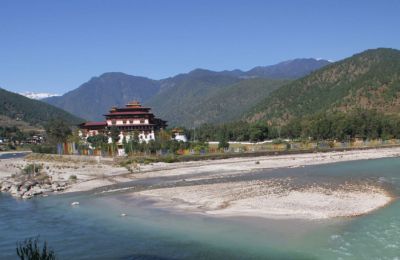
Bhutan Cultural Tour - 5 days
Bhutan Cultural Tour of 5 days lets you discover the rich Bhutanese culture. Visit ancient fortresses and Taktsang Monastery. Enjoy traditional hot stone bath.
Inquire Now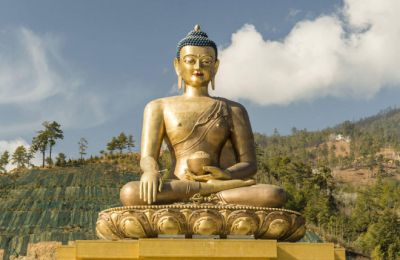
Bhutan Heritage Tour - 8 days
Bhutan Heritage Tour lets you explore centuries-old dzongs and Lakhangs built by Bhutanese kings and spiritual leaders. Take this Bhutan Heritage Tour and journey across the cultural hotspots of Bhutan, a fascinating Himalayan kingdom.
Inquire NowWhere to travel next?
Get help from our travel specialists for holiday ideas that matches your interests.
How much does a trip to Bhutan cost?
Prior to the COVID-19 pandemic, tour prices were fixed by the government, and the agencies were not at liberty to quote their own price. There was a fixed price that tourists had to pay a lump sum, where the charges for a visa, guide, transportation, food, accommodation, and entry fee to sites were all included. These days, depending on the kind of trip the visitor chooses, tour operators are free to set their own prices. In addition to the daily fee of USD 100, you will pay separately for hotel accommodation, food, guide, transportation, and entry fees to sites.
The total cost for your vacation in Bhutan will depend on many factors—the length of your stay, the type of accommodation you choose, and the activities you will indulge in. If you wish to travel independently and plan to tour only Thimphu and Paro, then your per-day cost (including SDF, accommodation, food, and transportation) will come to around USD240–300 if you plan on staying at a 3-star hotel. The cost will be higher if you choose five-star accommodation. In case you choose premium five-star accommodation, you should be prepared to pay around USD 700 to 1000 daily (including SDF, accommodation, food, and transportation).
If you choose a packaged tour, then the agency will include the following in your tour cost-hotel accommodation, licensed guide, transportation, 3 meals a day, visa fee, and all logistics for a trek in case you are trekking.
Rules are different for Indian Tourists
Indian tourists do not need a visa and can enter Bhutan without a passport. They can enter the country by showing their voter ID. During immigration, Indian tourists are given an entry permit for which they have to pay an SDF of INR 1200 for each night of their stay in Bhutan. For children (ages 6–12), there's a fifty percent concession. Children below five years do not have to pay any SDF.
The per-day fee is also not levied if an Indian national visits the Bhutanese border towns of Samdrup Jongkhar, Samtse, Phuentsholing, and Gelephuandexits on the same day.
Featured Trips
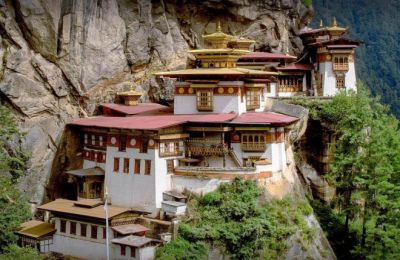
Nepal and Bhutan Tour - 9 days
Experience the beauty and culture of Nepal and Bhutan with our exclusive tour package for 2024/2025. Book now and create unforgettable memories!
Inquire Now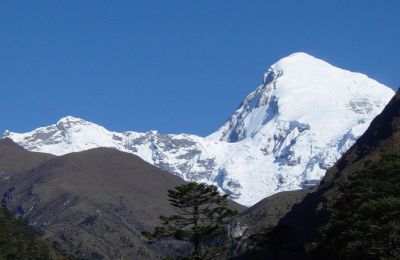
Jomolhari Trek - 11 days
Jomolhari Trek offers a taste of the great variety of Bhutanese landscapes and the most enchanting adventure trek in Bhutan. Jomolhari is the second-highest unclimbed mountain in Bhutan.
Inquire NowWhere to travel next?
Get help from our travel specialists for holiday ideas that matches your interests.
Top 10 Attractions in Bhutan
1. Tiger's Nest
One of the most well-liked trekking destinations in Bhutan is Tiger's Nest. Also known as Taktsang Monastery, it is situated in Paro. The monastery, which is built on a sheer rock face, is a sacred Buddhist pilgrimage site. It is believed that Padmasambhava, who is also known as the Second Buddha, traveled all the way from Tibet to Bhutan riding a flying tigress. He stopped at the cave where the monastery was built and meditated there for three years. This is one of the holiest sites in Bhutan, and local pilgrims along with tourists can be seen hiking to the monastery. To get to the trailhead, one needs to take a short drive from Parocityto the base of a hill. The hike is intense and takes around 5 to six hours to complete.
2. Paro Dzong and Ta Dzong
A visit to Paro Dzong and Ta Dzong offers you the chance to appreciate traditional Bhutanese architecture and learn more about the country's history. Dating back to the seventeenth century, the Paro Dzong houses government offices, a monastery, and courtyards where the annual Paro Tshechhu (a local Buddhist festival) is held.
Situated above Paro Dzong is the Ta Dzong, a circular watch tower that now houses the National Museum. Inside the museum are more than three thousand exhibits, including ancient Buddhist paintings and artifacts that are about two thousand years old.
3. Punakha Dzong
One of the most magnificent traditional fortress Bhutan is Punakha Dzong, which is located at the meeting point of the Male and Female rivers. This majestic fortress has beautiful access via a traditional wooden bridge. The fortress holds several small shrines, government offices, chapels, and courtyards.
4. Chimi Lakhang Temple
Known as the Fertility Temple, Chimi Lakhangis one of the oldest temples in Bhutan. Dedicated to the saint Drukpa Kuenly, or the Divine Madman, the shrine at the temple is a must-visit pilgrimage site for couples wishing to have a child. Married women walk around the temple carrying a wooden phallus three times in the hope of getting pregnant with a child. The temple can be accessed by hiking past paddy fields and the village of Sopsokha, where houses are decorated with paintings of giant phalluses (a sacred symbol for the Bhutanese to bring prosperity and ward off negative energy). The temple is located in Punakha.
5. Khamsum Yulley Namgyal Chorten
Khansum Yulley is a magnificent chorten located on top of a hill in Punakha. It is very different from other monasteries or temples, as this chorten was not built for worship. The chorten is built for protection and is dedicated to the wrathful Buddhist deities who can remove negative forces and evil spirits. From the top of the Chorten, one can enjoy amazing views of Punakha Valley and the mountains.
6. Dochu La Pass
The Dochu La Pass is a high mountain pass that one has to cross while traveling through Thimphu and Punakha. Situated at an elevation of 3100 meters, it is a motorable pass. Surrounded by majestic views of mountains and valleys, the pass is decorated with 108 memorials, or chortens, built in memory of martyred Bhutanese soldiers who lost their lives fighting Indian insurgents.
7. Buddha Dordenma
The Buddha Dordenmastatue is one of the most visited sites in Thimphu. Sitting on top of a hill overlooking Thimphu Valley, the Buddha Dordenma is a massive bronze statue of Shakyamuni Buddha rising to a height of 54 meters. There are 125,000 tiny Lord Buddha figurines within the statue. The Buddha Dordenma was built to commemorate the sixty-first anniversary of the fourth king of Bhutan, Jigme Singye Wangchuck, and it took about nine years to complete the statue.
8. Folk Heritage Museum
If you are traveling to the countryside, then you can enjoy an exhibition of village life and traditions at the Folk Heritage Museum. Located in Thimphu, the museum is housed in a traditional Bhutanese home and showcases traditional farming tools, utensils, and weapons used by the Bhutanese villagers. There is also a restaurant inside the museum where you can enjoy authentic Bhutanese cuisine.
9. Phobjika or Gangtey Valley
The Phobjika or Gangtey Valley is the nesting site of the endangered Black-necked cranes. Each winter, these majestic cranes travel from Tibet into Bhutan, spending their winters in this stunning U-shaped glacier valley. The Bhutanese worship these birds, and their arrival is seen as an auspicious event by the locals. To commemorate their arrival, the people even organize festivals. Known as the Black Necked Crane Festival, it is held in November every year at the Gangtey Monastery. Locals perform traditional songs, dances, and skits to celebrate the arrival of the birds.
10. Laya
A trip to Laya is for those looking for an off-beat destination. The land of the semi-nomadic indigenous tribe Layaps, Laya, is difficult to access from the main cities. One has to take an arduous ride on a mountain road from Thimphu to Gasa and hike from Gasa to reach Laya. Yak herders from Layawho live semi-nomadically spend a portion of the year in the mountains with their herds. This is one of the most pristine regions in Bhutan where people still follow their age-old customs and traditions.
Trekking and Hiking in Bhutan
Bhutan is known for its untouched hiking trails. These trails, which were once the lifeline of the villagers, have been abandoned after the roads were built and are now only used by yak herders and nomads. These trails weave past stunning scenery filled with alpine meadows, glacial rivers, and snow-capped mountains. Some of the best-known Himalayan treks in Bhutan are the Druk Path Trek, the Jomolhari Trek, the Bumdra Monastery Trek, the Snowman Trek, the Dagala Thousand Lakes Trek, and the Laya Gasa Trek.
The Trans-Bhutan Trail, a newly restored walking trail, offers intrepid trekkers an immersive trekking experience by taking them across ancient monasteries, Buddhist shrines, and villages stretching from east to west of the country.
One can experience old-style camping while trekking in Bhutan. As there are no shops or lodges along the trails, all supplies needed for the trek have to be carried by mules and horses. A team of local support staff will accompany trekkers while trekking in Bhutan. They will be in charge of setting up the
campsite at each stop, preparing food, and guiding the clients throughout the trek. Independent trekking is not allowed in Bhutan, and one should book a package with a trekking agency if one wishes to trek in Bhutan.
Unusual Experiences You Should Try While in Bhutan
Create Your Own Customized Postage Stamp
At the General Bhutan Post Office in Thimphu, you can create your own postage stamp by paying a fee of 500 Ngultrum. (approximately 6 USD) You can use your own photo with one of Bhutan's landmarks as a background. The personalized postage stamps will be valid and can be used to send postcards or letters from Bhutan.
Make Traditional Handmade Paper
Bhutanese traditional paper known as Desho is made from the bark of Daphne and Dekap trees. Products made from desoh, like notebooks, gift wrappers, lampshades, greeting cards, etc., are exported to western countries. You can visit one of the old paper-making factories and observe the ancient process of making paper from wood pulp. You can also make your own paper using dried flowers, leaves, or chilies.
Participate in a game of Dhaor archery
Archery is the national sport of Bhutan. One will find an archery range at any large locality or village. Bhutanese men usually entertain themselves with a game of archery. Rival teams try to outdo each other by trying to hit the target that is placed 145 meters away. Once a target is hit, the winning team celebrates with whoops and loud songs and dances. It is indeed a great experience to participate in or watch a game of archery. Duels are fought using traditional bows and arrows made of bamboo.
Wear the Bhutanese Traditional Attire
The Bhutanese traditional dress is made from fabric woven by hand. While men wear 'Gho', the traditional attire of women is called 'Kira'. Bhutanese wear their traditional dress with pride, and Bhutan is one of the few countries in Asia where the traditional dress has been made mandatory at government offices and educational institutions. You can make your trip to Bhutan memorable by buying a Gho or a Kira and taking pictures wearing it.
Get Introduced to a Takin
The Takin is a unique animal found only in some parts of Asia. This strange-looking animal with the face of a moose and the body of a cow or small bison is the national animal of Bhutan. To get a peek at this strange mammal, you can head to the Royal Motithang Takin Preserve in Thimphu.
Try the traditional Bhutanese dish made with chilies
Ema Datshi, or chilies with cheese, is the traditional dish of Bhutan. Eaten with rice and other side dishes, this dish is really spicy and not for the fainthearted.
Enjoy a Hot Stone Bath
Bhutanese love to detoxify their body by soaking themselves in a hot wood tub where water is heated using hot river stones. While in Bhutan, you should absolutely try a hot stone bath. Hotels and spas do offer it, but for a more authentic experience, you can enjoy this traditional bath at a local homestay or farmhouse. This is especially relaxing after a long hike or trek. Large stones are heated in the open fire and immersed in the bath water. Local medicinal herbs are also added to the bath water, which makes the bathing experience therapeutic.
Stay at a Local Farm
Spend a day at a local village and stay at a farmhouse. Staying at a farm will be an insightful experience and will lead you to understand and appreciate the simple lifestyle of the Bhutanese farmers.
Conclusion
Bhutan is one of the best-kept secrets of the Himalayas. It is a destination where one can discover age-old Buddhist customs and traditions plus a pristine landscape. It is a place where the preservation of the environment, culture, and happiness takes center stage. A small country where trees and monasteries outnumber the human population. Bhutan is a peaceful country.
Here you can experience a vibrant Buddhist culture and nature that is deemed sacred and divine. But before you embark on your tour, it's important that you know about the rules that Bhutan has for tourists. To help you plan your trip, this article includes Everything you need to know to plan your trip to Bhutan for 2025 and 2026. Hope you will find the required information and find this a helpful read to arrange your travel.
- Written by: Naba Raj Amgai
Updated: Jul, 14, 2024
















